As New Holland rolled the two millionth tractor off its Basildon tractor line, it too marked another milestone, which was the official UK harvest launch of the Next Generation design CR10 and CR11 combines near Chelmsford, Essex.
At the field event, New Holland also presented its latest product updates and solutions, which included the T7.340 HD tractor, T7.270 Methane Power tractor and its new PLM Connect telematics portal, all of which we will cover in depth at a later date.
Same, but very different
In 2014, New Holland broke the record for the most wheat harvested within eight hours with its CR10.9 twin rotor combine – a record that to date has been officially unbeaten. Since then all major manufacturers have come to the fore with new flagship models claiming mind boggling performance stats. At Agritechnica 2023, New Holland partially unveiled the CR11 flagship combine becoming the latest brand to launch a new flagship machine. Earlier this year, the slightly less powerful CR10 model was added.
In 1975, New Holland first launched its twin-rotor threshing and separation technology, almost 50 years on, the design has evolved, but the twin longitudinal rotors remain.
That said, the CR10/CR11 project has been one of the largest ever undertaken by New Holland and the accumulation of 10 years’ work from the team at its combine facility in Zedelgem, Belgium. The result is a fully revised machine with over 90% new components, compared to the current CR models, all in aid of being able to handle greater crop flows.
For obvious reasons, Ireland was not the target market for the CR10/CR11, but what we found most impressive was the degree of R&D that has gone into the new models to improve output, while simultaneously simplifying the driveline. The CR10/CR11 use 25% fewer components and no chain drives, according to New Holland. Upon opening the side panels of most combines, the majority of people would be mesmerised by the number of pulleys, belts, shafts, etc. This is not the case with the new CR models. For instance, both machines have no daily grease nipples and in the region of 15 in total (the majority of which are on the header).
The only differences between the CR10 and CR11 is engine and grain tank capacity. The CR11 features a 20,000-litre grain tank and a 15.9-litre FPT Cursor 16 engine producing 775hp. The CR10 engine is a 12.9-litre FPT Cursor 13 generating 635hp, while its grain tank holds 16,000l.
More in, more out
Starting at the front, the CR10/CR11 combines can accommodate cutterbar widths from 10.6m (35ft) to 15m (50ft), draper options supplied by MacDon. Naturally, if more crop goes in, then the threshing and separation systems need to be able to process it. According to Nigel Honeyman, UK combine specialist for New Holland, one of the challenges in designing the CR10/CR11 was the knock-on result of increasing capacity in one area and how it affected the next. This is why there has been such severe upgrades below the surface which then inevitably needed years of field testing.
The feeder house and drum is wider than before, the rotors at 600mm (24in) are larger and longer, meaning threshing, seperation and grain cleaning areas have increased. As a result, a larger grain elevator (picture two) has been added along with a larger grain tank and unloading auger. The residue management system also needed upgrading, to cope with the additional volume of straw.
On the CR10/CR11, the operator can now control more functions remotely from the cab, including rotor speed, which is now synced with the Dynamic Feed Roll (DFR) system, the reversing of the header, feeder house, and full operation of the straw chopper. The large stone trap in front of the DFR can now be optioned with hydraulic activation from the cab.
Each rotor features 40 standard rasp bars, eight HX raspbars and 12 spiked raspbars. The HX units combine the height of spiked raspbars with the profile of the standard units, with a greater sidewall angle helping accelerate crop flow in the transition zone of the stepped rotor cage, between the threshing zone and the separation zone.
A new vane design aids crop ejection in the event that the rotors need to be reversed, while the vane angle is also remotely controlled from the cab. During an automatic unblock sequence, a hydraulic ram automatically inverses the belt tensioner to take up belt slack in the other direction.
New rotor cages feature a stepped design, with a broader cage and higher vanes in the separation area, to improve crop movement and separation as a result. The concave area comprises two sets of three lightweight threshing concaves and separation grates, and two sets of six, lightweight grates (picture one).
New TwinClean cleaning shoe
The new TwinClean cleaning shoe is one particular area that New Holland feels is a real selling point of the new machines. There is essentially two of everything, including two sieve systems in sequence, each with its own upper and lower sieves and clean grain auger. Both are based around a large grain pan, with an increased fall step to the first upper sieve. The reasoning behind two clean grain augers as opposed to one large auger is to reduce grain damage, which is said to be reduced with two counter rotating augers. 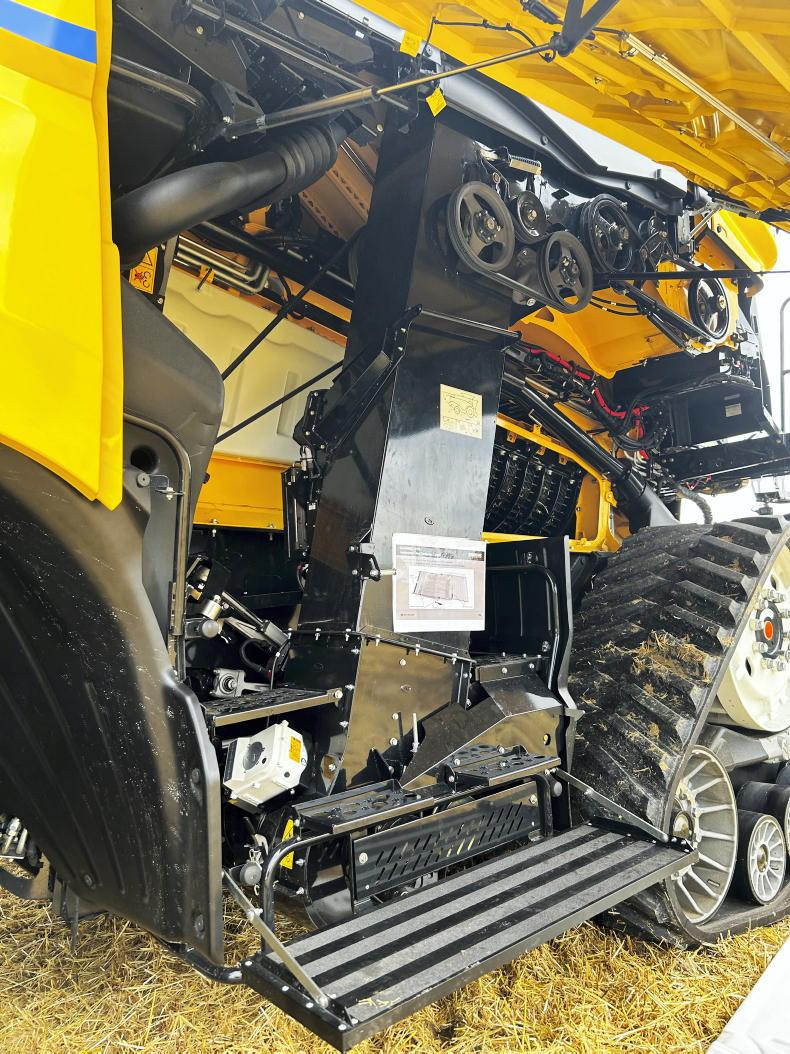
The clean grain elevator is fed by two counter-rotating augers.
Airflow is provided by a high-power cleaning shoe fan. Two pairs (four) of pressure sensors, on the grain pan and on the upper sieves, continuously measure the cleaning shoe load and detect any anomalies in material distribution between left and right. Depending on the sensor readings, a side-shake mechanism in the form of an electric actuator adds a lateral movement component to the grain pan and upper sieves to even out the material over the cleaning shoe’s full width. This, New Holland claims, increases throughput while minimising losses. As such, the cleaning shoe can compensate for uneven feeding and side slopes up to 28%. Overall size of the complete sieve area is 8.76m².
Grain tanks
The CR11 grain tank holds 20,000l (picture three) with an unloading rate of 210 l/sec, while the CR10 tank holds 16,000l and has a 159l/sec unloading rate. Cross-auger shut-off allows the unloading auger to be fully emptied, even when the grain tank still holds grain. On the CR11, an option allows unloading speed to be reduced by 50% by disengaging the front-cross auger to precisely complete the filling of trailers. An adjustable auger spout is fitted as standard.
Bigger chopper for bigger volumes
CR10 and CR11 combines can be equipped with either a standard integrated chopper or a high hood-mounted fine-chop unit (picture four). The standard integrated chopper features 60 fixed blades, which work in conjunction with 52 counter knives, working at 3,000rpm for chopping, or at 800rpm for straw swath laying. Manual adjustment of the counter knives is standard, and remote hydraulic adjustment optional.
A driven roller assists straw ejection when swathing, or into the spreader impellers when chopping. The two hydraulically-driven 800mm impellers, each equipped with three paddles, spread chopped material at widths up to 15m (50ft). An oscillating deflector behind the spreaders creates a dynamic pulsating effect on the residue spreading, to ensure even distribution over the full cutting width.
The optional high-hood chopper leads with a 500mm beater with two rows of spikes and two rows of blades, plus a non-perforated beater pan. This is followed by a six-row chopper with 88 flail knives and 67 counter knives. The chopper can operate at low (900rpm) or high (3,600rpm) speed, with a neutral position for free movement when servicing is required. Remote chopper speed selection is optional. The pair of hydraulically-driven 970mm-diameter impellers on this unit each feature five paddles, capable of distributing material at up to 18m (61ft). As on the standard unit, an oscillating deflector is again fitted. A radar option is available to monitor the width of the residue spread and adjust spreader speed for full width performance. A chopper loader indicator is also optionally available.
Cab and comfort
The cab layout in CR10/CR11 models now follows a similar architecture to the PMLI cab found on the larger T7 and T8 tractors. It features the Intelliview 12 crisp-clear touchscreen terminals, one of which is dedicated to the management of the combine, while the other is dedicated to guidance (picture eight). 
Twin intelliview 12 touchscreen terminals are fitted, one for machine management and the other for guidance.
Both combines are equipped with three cameras, providing views to the rear, of the grain tank and of the unloading auger spout, while a 360° bird’s-eye view camera is optional. The fit and finish of the cab has also been updated to now include new multizone climate control, a new steering wheel and premium cloth or leather seats, etc. The lighting package has also been upgraded as standard, with optional ‘far distance’ lights also available.
A Core PLM Intelligence package covers the most common automatic features, such as IntelliSense, where automatic adjustments occur according to the harvest strategy chosen by the operator, ie losses, grain quality, max capacity, etc. The second option is an Advanced PLM Intelligence bundle, aimed at those with the most advanced demands. Correction signal packages for IntelliSteer automated steering and other functions such as yield and moisture mapping, are available from the factory in two accuracy levels. Via the optional IntelliField software, at no cost, owners and operators are instantly provided with in-field data and can share boundaries, guidance lines and coverage data where multiple machines are operating in the same field.
Drivetrain
The engine is now mounted longitudinally in line and at the same angle as the rotors to minimise power losses. As a result, all drives are positioned at the back of the engine on an easily accessed transmission (picture six). The cooling pack has been relocated to between the engine and the grain tank, reducing noise inside the cab and where the cleanest air possible can be drawn in. Power is transferred from the engine bay and down along the right hand side via an enclosed drive shaft to the feeder house (picture seven).
Both models feature a two-speed hydrostatic transmission and TerraLock semi-automatic diff lock. Units specified with SmartTrax track units are available with three belt width options of 660mm/26in, 810mm/32in and 910mm/36in, with rubber or hydraulic cushioning.
The revised driveline and reduction in components under the left and right panels have allowed the fitment of 36in tracks to be possible while keeping overall width under 4m. The optional 4wd system has also been updated and instead of using individual rear-wheel motors, now uses one large motor mounted on the axles differential. All exhaust manifold/turbo/after treatment components are fully isolated to reduce surface temperature of hot components. Hydraulic hose routing has been redesigned to improve access and simplicity.
All harvest hydraulic drives are disengaged mechanically via a clutch in the main engine gearbox at start-up or during road travel, reducing drag and saving up to 20hp/15kW of power. The use of load-sensing pumps further reduces hydraulic power demands and improves efficiency.


The clean grain elevator is fed by two counter-rotating augers.

The CR10 features a 16,000l grain tank, while the CR11 features a 20,000l tank.

The CR10/CR11 have larger (600mm) and longer rotors compared to any other CR combine.
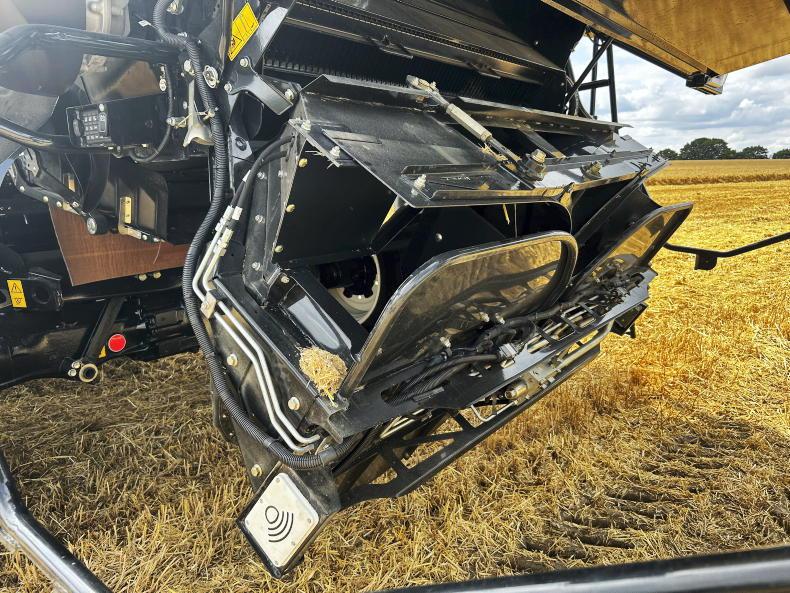
Two chopper options are available, the standard integrated chopper or a high, hood-mounted fine-chop unit.
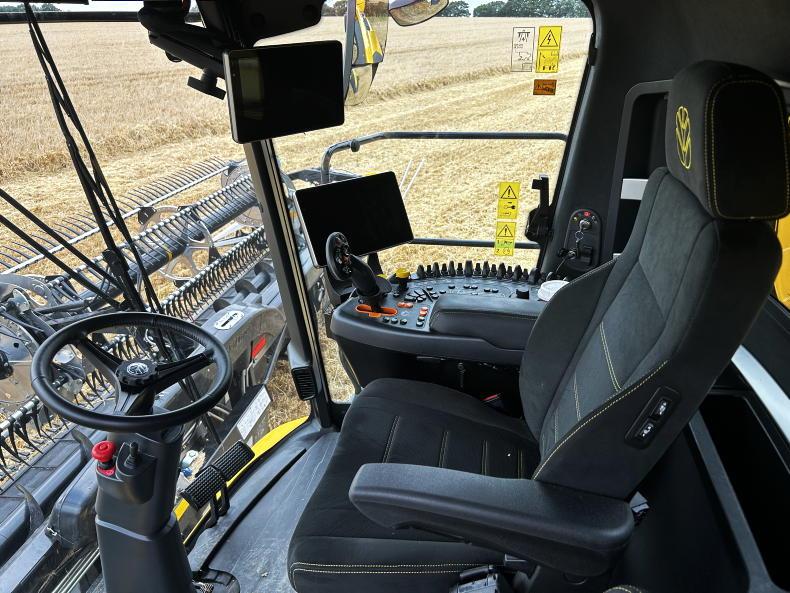
The revised cab includes new-style brake pedals and foot pegs, a luxury steering wheel and premium cloth or leather seats, plus new multizone climate control, with floor level air ducts.

A maintenance-free drive shaft transfers power from the gearbox to the feeder house, eliminating the need for pulleys and belts.
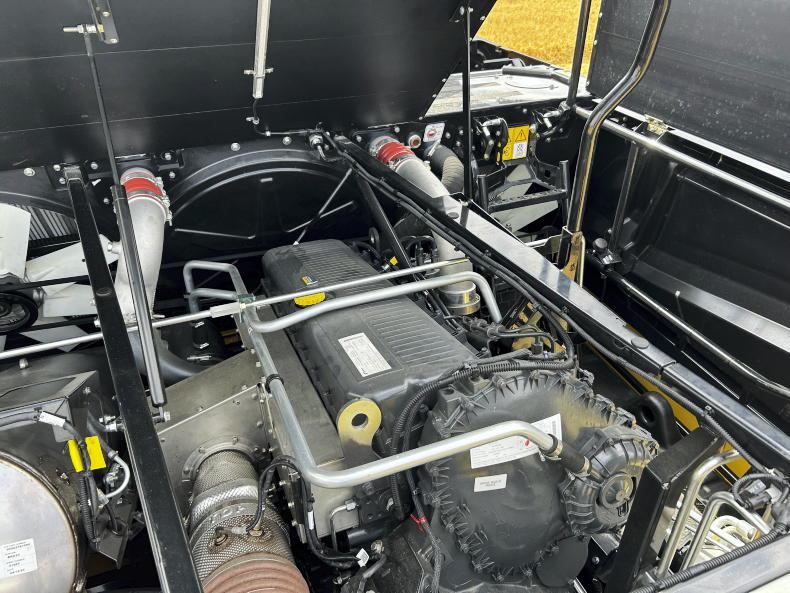
The FPT Cursor 13 in the CR10 produces a maximum 635hp, while the Cursor 16 in the CR11 churns out a maximum 775hp.
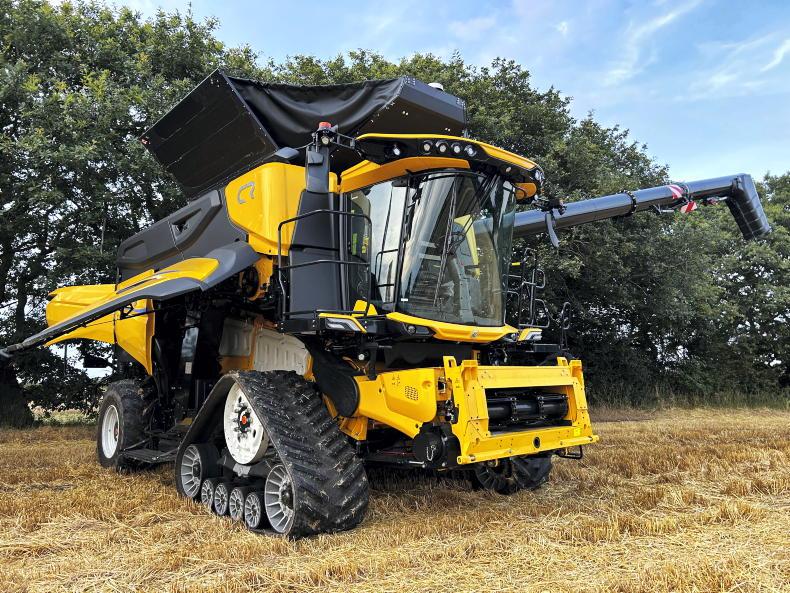
Just over 40 units are said to have been built for the 2024 harvest season.
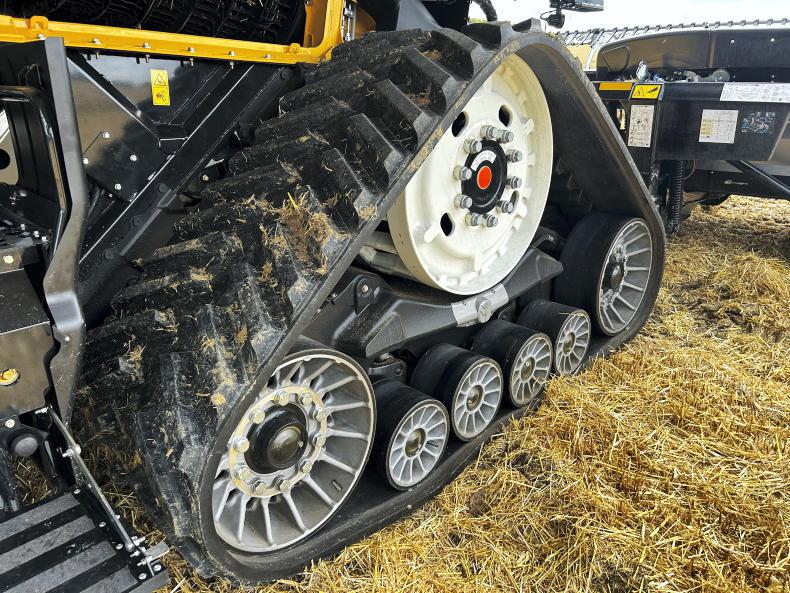
Models specified with SmartTrax are available with three track belt width options of 660mm/26in, 810mm/32in and 910mm/36in, with rubber or hydraulic cushioning.

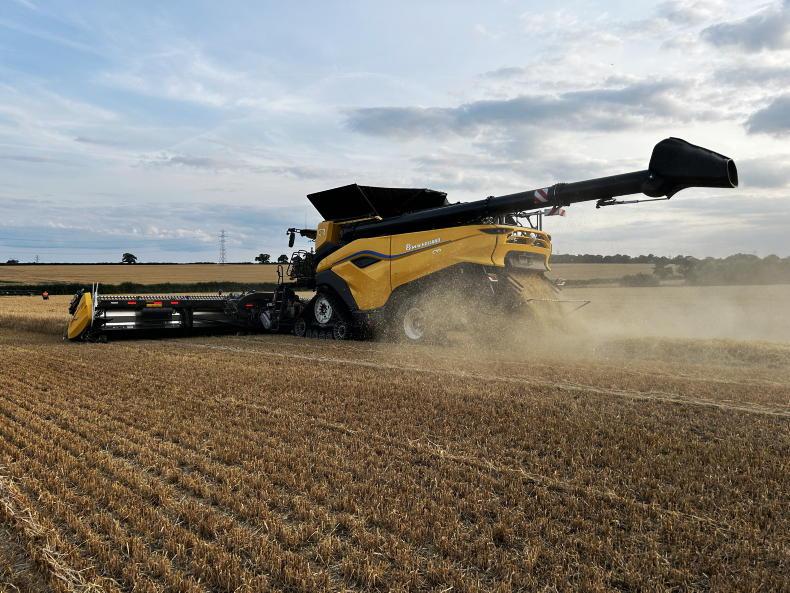
The CR10 has a maximum unloading rate of 159l/sec, while the CR11 has a maximum unloading rate of 210l/sec.
As New Holland rolled the two millionth tractor off its Basildon tractor line, it too marked another milestone, which was the official UK harvest launch of the Next Generation design CR10 and CR11 combines near Chelmsford, Essex.
At the field event, New Holland also presented its latest product updates and solutions, which included the T7.340 HD tractor, T7.270 Methane Power tractor and its new PLM Connect telematics portal, all of which we will cover in depth at a later date.
Same, but very different
In 2014, New Holland broke the record for the most wheat harvested within eight hours with its CR10.9 twin rotor combine – a record that to date has been officially unbeaten. Since then all major manufacturers have come to the fore with new flagship models claiming mind boggling performance stats. At Agritechnica 2023, New Holland partially unveiled the CR11 flagship combine becoming the latest brand to launch a new flagship machine. Earlier this year, the slightly less powerful CR10 model was added.
In 1975, New Holland first launched its twin-rotor threshing and separation technology, almost 50 years on, the design has evolved, but the twin longitudinal rotors remain.
That said, the CR10/CR11 project has been one of the largest ever undertaken by New Holland and the accumulation of 10 years’ work from the team at its combine facility in Zedelgem, Belgium. The result is a fully revised machine with over 90% new components, compared to the current CR models, all in aid of being able to handle greater crop flows.
For obvious reasons, Ireland was not the target market for the CR10/CR11, but what we found most impressive was the degree of R&D that has gone into the new models to improve output, while simultaneously simplifying the driveline. The CR10/CR11 use 25% fewer components and no chain drives, according to New Holland. Upon opening the side panels of most combines, the majority of people would be mesmerised by the number of pulleys, belts, shafts, etc. This is not the case with the new CR models. For instance, both machines have no daily grease nipples and in the region of 15 in total (the majority of which are on the header).
The only differences between the CR10 and CR11 is engine and grain tank capacity. The CR11 features a 20,000-litre grain tank and a 15.9-litre FPT Cursor 16 engine producing 775hp. The CR10 engine is a 12.9-litre FPT Cursor 13 generating 635hp, while its grain tank holds 16,000l.
More in, more out
Starting at the front, the CR10/CR11 combines can accommodate cutterbar widths from 10.6m (35ft) to 15m (50ft), draper options supplied by MacDon. Naturally, if more crop goes in, then the threshing and separation systems need to be able to process it. According to Nigel Honeyman, UK combine specialist for New Holland, one of the challenges in designing the CR10/CR11 was the knock-on result of increasing capacity in one area and how it affected the next. This is why there has been such severe upgrades below the surface which then inevitably needed years of field testing.
The feeder house and drum is wider than before, the rotors at 600mm (24in) are larger and longer, meaning threshing, seperation and grain cleaning areas have increased. As a result, a larger grain elevator (picture two) has been added along with a larger grain tank and unloading auger. The residue management system also needed upgrading, to cope with the additional volume of straw.
On the CR10/CR11, the operator can now control more functions remotely from the cab, including rotor speed, which is now synced with the Dynamic Feed Roll (DFR) system, the reversing of the header, feeder house, and full operation of the straw chopper. The large stone trap in front of the DFR can now be optioned with hydraulic activation from the cab.
Each rotor features 40 standard rasp bars, eight HX raspbars and 12 spiked raspbars. The HX units combine the height of spiked raspbars with the profile of the standard units, with a greater sidewall angle helping accelerate crop flow in the transition zone of the stepped rotor cage, between the threshing zone and the separation zone.
A new vane design aids crop ejection in the event that the rotors need to be reversed, while the vane angle is also remotely controlled from the cab. During an automatic unblock sequence, a hydraulic ram automatically inverses the belt tensioner to take up belt slack in the other direction.
New rotor cages feature a stepped design, with a broader cage and higher vanes in the separation area, to improve crop movement and separation as a result. The concave area comprises two sets of three lightweight threshing concaves and separation grates, and two sets of six, lightweight grates (picture one).
New TwinClean cleaning shoe
The new TwinClean cleaning shoe is one particular area that New Holland feels is a real selling point of the new machines. There is essentially two of everything, including two sieve systems in sequence, each with its own upper and lower sieves and clean grain auger. Both are based around a large grain pan, with an increased fall step to the first upper sieve. The reasoning behind two clean grain augers as opposed to one large auger is to reduce grain damage, which is said to be reduced with two counter rotating augers. 
The clean grain elevator is fed by two counter-rotating augers.
Airflow is provided by a high-power cleaning shoe fan. Two pairs (four) of pressure sensors, on the grain pan and on the upper sieves, continuously measure the cleaning shoe load and detect any anomalies in material distribution between left and right. Depending on the sensor readings, a side-shake mechanism in the form of an electric actuator adds a lateral movement component to the grain pan and upper sieves to even out the material over the cleaning shoe’s full width. This, New Holland claims, increases throughput while minimising losses. As such, the cleaning shoe can compensate for uneven feeding and side slopes up to 28%. Overall size of the complete sieve area is 8.76m².
Grain tanks
The CR11 grain tank holds 20,000l (picture three) with an unloading rate of 210 l/sec, while the CR10 tank holds 16,000l and has a 159l/sec unloading rate. Cross-auger shut-off allows the unloading auger to be fully emptied, even when the grain tank still holds grain. On the CR11, an option allows unloading speed to be reduced by 50% by disengaging the front-cross auger to precisely complete the filling of trailers. An adjustable auger spout is fitted as standard.
Bigger chopper for bigger volumes
CR10 and CR11 combines can be equipped with either a standard integrated chopper or a high hood-mounted fine-chop unit (picture four). The standard integrated chopper features 60 fixed blades, which work in conjunction with 52 counter knives, working at 3,000rpm for chopping, or at 800rpm for straw swath laying. Manual adjustment of the counter knives is standard, and remote hydraulic adjustment optional.
A driven roller assists straw ejection when swathing, or into the spreader impellers when chopping. The two hydraulically-driven 800mm impellers, each equipped with three paddles, spread chopped material at widths up to 15m (50ft). An oscillating deflector behind the spreaders creates a dynamic pulsating effect on the residue spreading, to ensure even distribution over the full cutting width.
The optional high-hood chopper leads with a 500mm beater with two rows of spikes and two rows of blades, plus a non-perforated beater pan. This is followed by a six-row chopper with 88 flail knives and 67 counter knives. The chopper can operate at low (900rpm) or high (3,600rpm) speed, with a neutral position for free movement when servicing is required. Remote chopper speed selection is optional. The pair of hydraulically-driven 970mm-diameter impellers on this unit each feature five paddles, capable of distributing material at up to 18m (61ft). As on the standard unit, an oscillating deflector is again fitted. A radar option is available to monitor the width of the residue spread and adjust spreader speed for full width performance. A chopper loader indicator is also optionally available.
Cab and comfort
The cab layout in CR10/CR11 models now follows a similar architecture to the PMLI cab found on the larger T7 and T8 tractors. It features the Intelliview 12 crisp-clear touchscreen terminals, one of which is dedicated to the management of the combine, while the other is dedicated to guidance (picture eight). 
Twin intelliview 12 touchscreen terminals are fitted, one for machine management and the other for guidance.
Both combines are equipped with three cameras, providing views to the rear, of the grain tank and of the unloading auger spout, while a 360° bird’s-eye view camera is optional. The fit and finish of the cab has also been updated to now include new multizone climate control, a new steering wheel and premium cloth or leather seats, etc. The lighting package has also been upgraded as standard, with optional ‘far distance’ lights also available.
A Core PLM Intelligence package covers the most common automatic features, such as IntelliSense, where automatic adjustments occur according to the harvest strategy chosen by the operator, ie losses, grain quality, max capacity, etc. The second option is an Advanced PLM Intelligence bundle, aimed at those with the most advanced demands. Correction signal packages for IntelliSteer automated steering and other functions such as yield and moisture mapping, are available from the factory in two accuracy levels. Via the optional IntelliField software, at no cost, owners and operators are instantly provided with in-field data and can share boundaries, guidance lines and coverage data where multiple machines are operating in the same field.
Drivetrain
The engine is now mounted longitudinally in line and at the same angle as the rotors to minimise power losses. As a result, all drives are positioned at the back of the engine on an easily accessed transmission (picture six). The cooling pack has been relocated to between the engine and the grain tank, reducing noise inside the cab and where the cleanest air possible can be drawn in. Power is transferred from the engine bay and down along the right hand side via an enclosed drive shaft to the feeder house (picture seven).
Both models feature a two-speed hydrostatic transmission and TerraLock semi-automatic diff lock. Units specified with SmartTrax track units are available with three belt width options of 660mm/26in, 810mm/32in and 910mm/36in, with rubber or hydraulic cushioning.
The revised driveline and reduction in components under the left and right panels have allowed the fitment of 36in tracks to be possible while keeping overall width under 4m. The optional 4wd system has also been updated and instead of using individual rear-wheel motors, now uses one large motor mounted on the axles differential. All exhaust manifold/turbo/after treatment components are fully isolated to reduce surface temperature of hot components. Hydraulic hose routing has been redesigned to improve access and simplicity.
All harvest hydraulic drives are disengaged mechanically via a clutch in the main engine gearbox at start-up or during road travel, reducing drag and saving up to 20hp/15kW of power. The use of load-sensing pumps further reduces hydraulic power demands and improves efficiency.


The clean grain elevator is fed by two counter-rotating augers.

The CR10 features a 16,000l grain tank, while the CR11 features a 20,000l tank.

The CR10/CR11 have larger (600mm) and longer rotors compared to any other CR combine.

Two chopper options are available, the standard integrated chopper or a high, hood-mounted fine-chop unit.

The revised cab includes new-style brake pedals and foot pegs, a luxury steering wheel and premium cloth or leather seats, plus new multizone climate control, with floor level air ducts.

A maintenance-free drive shaft transfers power from the gearbox to the feeder house, eliminating the need for pulleys and belts.

The FPT Cursor 13 in the CR10 produces a maximum 635hp, while the Cursor 16 in the CR11 churns out a maximum 775hp.

Just over 40 units are said to have been built for the 2024 harvest season.

Models specified with SmartTrax are available with three track belt width options of 660mm/26in, 810mm/32in and 910mm/36in, with rubber or hydraulic cushioning.


The CR10 has a maximum unloading rate of 159l/sec, while the CR11 has a maximum unloading rate of 210l/sec.






















 This is a subscriber-only article
This is a subscriber-only article










SHARING OPTIONS: